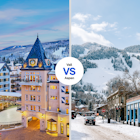
North Face Futurelight: the next fabric to usurp Gore-Tex?

Sep 30, 2019 • 5 min read

Will North Face win its bet on FutureLight? Only time will tell.
It's been 20 years since someone first tried to overtake Gore-Tex’s half-century reign as the most popular waterproof fabric. That someone was eVent, and although the fabric maker is still used by a limited number of textiles, it’s largely regarded as a less-reliable alternative. When it comes to waterproof-but-breathable outerwear, Gore-Tex has remained the industry eponym.
This fall, however, North Face hopes to become the newest challenger – and eventual champion – of waterproof supremacy with its new FutureLight fabric. Launching on October 1, FutureLight uses “nano spun” micro threads, which promise twice as much breathability with equal waterproofing and durability. The new material also promises “whisper-quiet softness,” unlike Gore-Tex’s trademark whooshy sound.
At over $1000 for both jacket and pants, however, FutureLight is launching the winter wear equivalent of a top-of-the-line, expensive iPhone, made for the most extreme and moneyed outdoorsmen. I had to wonder – is this new fabric worth the price and the hype?
Earlier this spring, I was able to test both the FutureLight jacket and pants against the competition on a three-day ski tour of the Aspen-Snowmass backcountry, in addition to resort skiing at both Aspen Highlands and Aspen Mountain (aka Ajax). Not only was the experience encouraging, it highlighted one of the nation’s greatest recreational mountain ranges.

FutureLight works as advertised
As if I needed any more help standing out as an amateur on the mountain, there I was in bright, school-bus yellow. At first, I was skeptical of the lack of armpit and leg zipper vents, which are commonly used in Gore-Tex jackets and pants for extra breathability.
I was equally unsure of the pajama-like thinness of both the FutureLight jacket and pants. “Will this really keep me warm?” I asked myself. After all, the FutureLight suit felt twice as thin as the fabric it hopes to displace.
Related Articles
Gearhead's guide to skiing in the US
Budget skiing: save money on the piste
Over my head: Going to the backcountry for a first skiing experience
As any well-informed human on a snowy mountain would do, I, of course, wore layers. But I purposely wore the same amount that I would under noticeably thicker Gore-Tex clothing. While hiking, split-boarding, and skiing alongside (and, if I'm honest, somtimes behind) the professional alpinists whom North Face invited to chaperone me, I stayed comfortable for the duration of my visit.
Another plus, FutureLight is several times quieter than Gore-Tex, eVent, or any other nylon-based fabric. It’s not as silent as cotton. But FutureLight most resembles a very light jacket, rather than the loud whooshing sound that most outdoor and windbreakers regularly make. This is especially noticeable when compared side-by-side with other water and windproof fabrics. If this is the future, it will thankfully be a much less obnoxious one.

Aspen, like FutureLight, makes the most of winter
In addition to FutureLight’s effectiveness, I also learned something else on this trip: Aspen lives up to its reputation as a terrain-filled and posh setting for winter sports. Although I love my native Utah, if I’m really being fair, this Colorado mountain town probably beats Park City in the “delightful downtown” department.
I first noticed this after landing at the adorably small and golden-lit airport just after nightfall. While catching a cab to my hotel, The Limelight, I asked my driver why the Christmas lights endured into March. He replied, “They stay up all year round." Which, I discovered, is kind of like the pace of activities on and off piste in Aspen.
Across three days, I hiked the Highland bowl, then down-hilled it by snowboard. I backcountry split-boarded in Maroon Bells (which is accessed through Aspen Highlands resort) and rode some of the freshest lines in my life. I also enjoyed the classic slopes of Aspen Mountain (which are within walking distance to the Limelight), enjoyed an amazing snowcat dinner at Cloud Nine, and rejuvenated in the heated pool and hot tub under massive Colorado snowflakes.

Throughout it all, my internal combustion helped keep me warm inside my FutureLight jacket and pants. But get this - I never overheated. Not once. No sweat tacos. No clammy or swampy feeling under my jacket or pants. No removing or adding layers ad nauseum as the hours and activities wore on. Instead, I quickly learned that I could trust FutureLight to work and adapt as my body did to the terrain, altitude, wind conditions, snow, and physical exertion associated with climbing and then riding down the mountain.
Of the four resorts within the city limits, I only missed Aspen Buttermilk and Aspen Snowmass – two good reasons to return. Sure, like FutureLight itself, Aspen is a little more expensive. But with so many options and corners to explore while you stay warm and dry, both FutureLight and Aspen are well worth experiencing if you're a serious ski-lover.
Is FutureLight the “future of outerwear”?
North Face says that FutureLight is “the future of outerwear.” Although my preliminary trials are in no way exhaustive enough to dethrone Gore-Tex just yet – only time will tell if FutureLight proves as reliable – the latter works remarkably well in both wet and winter conditions. And despite its premium price, it does its job with a lot less of the bulk, zippered vents, loud fabrics, and extra layers that have sometimes frustrated Gore-Tex users. Will FutureLight someday launch at a mainstream price? For winter sports and wet weather fans, I sure hope so.
Get more travel inspiration, tips and exclusive offers sent straight to your inbox with our weekly newsletter. Check out adventure tours for every traveller from our trusted partners.
Explore related stories









